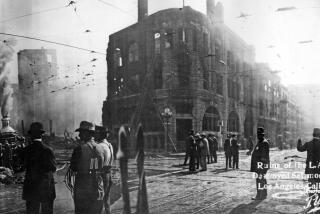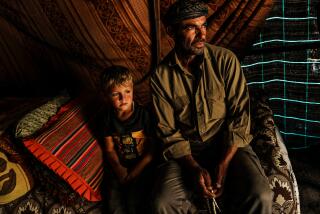Anguish and Hope, Then the Miracle: No Bad News
Their faces were on the front page of every newspaper in the country, their words--one man’s regret that he hadn’t kissed his wife that morning, another’s request for a cold beer--led off every TV and radio news program. The nine coal miners trapped for 72 hours in the frigid, watery depths of a mine in Quecreek, Pa., were pulled not only to safety early Sunday morning, they were drawn into the thankful embrace of a nation passionately grateful for a story with a happy ending.
The rescue was dubbed by virtually everyone who spoke of it as a miracle, an answer to a million prayers. “Thank you God,” read a sign stuck in the window of a nearby restaurant. Details of the men’s ordeal--how they tied themselves together so their bodies would all be found, how they put wills and goodbye letters to their families in a bucket, how they snuggled with each other to stay warm--were pored over by Americans moved to tears and buoyed by a new sense of elation--maybe, in a summer plagued by horrible news, things were beginning to turn around.
For the record:
12:00 a.m. Aug. 2, 2002 For The Record
Los Angeles Times Friday August 02, 2002 Home Edition Main News Part A Page 2 National Desk 10 inches; 380 words Type of Material: Correction
Misspelled name--A story in Tuesday’s edition of Southern California Living about the miners being rescued in Pennsylvania misspelled the name of a Los Angeles girl who fell down a well in 1948. Her name was Kathy Fiscus.
For The Record
Los Angeles Times Saturday August 03, 2002 Home Edition Main News Part A Page 2 National Desk 8 inches; 307 words Type of Material: Correction
Well accident --A story in Tuesday’s Southern California Living about nine miners rescued in Pennsylvania gave the wrong year for when a Los Angeles girl fell down a well. The accident involving Kathy Fiscus occurred in 1949. A correction that ran Friday also had the year wrong.
People trapped underground are always news. The attempted rescue of spelunker Floyd Collins in 1925 became what is considered the very first media frenzy. Almost 25 years later, coverage of efforts to rescue a 3-year-old girl who had fallen down an abandoned well in San Marino established the nascent KTLA-TV Channel 5 and introduced many Angelenos to the power of TV news.
Since then, the media and the public have developed a standard ritual of disaster and rescue--of vigil-keeping both physical and electronic. “It’s almost a genre,” says Neil Gabler, cultural analyst and author of “Life: the Movie.” “People in dire circumstances, will they survive, the families, the rescuers--Americans are used to that convention. So this story would have been heavily reported anyway. But there is no denying that Americans are pouring more into it because of its context.”
Context being a month that has headlined child-rape and murder, pederasty in the Catholic Church, multimillion-dollar book cooking in the corporate sector and an ongoing war against terrorism. Context being a year dominated by the maiming of the Pentagon and the destruction of the World Trade Center.
“Confidence has been shaken in three pillars of American life--religious, economic and government,” says Gabler. “We really need something that gives us some hope, some encouragement.”
Even something as relatively small and finite as the rescue of nine men.
The three-day vigil Americans kept as rescuers tried to gauge the miners’ whereabouts and then drill through the earth was a haunting reminder of other recent days of waiting and watching--for news of abducted children, for statements to be made after chief executives and priests were led away in handcuffs, for the fires in the West to burn themselves out, for the market to steady itself.
It echoed even the days many spent in horrified prayer as firefighters and rescue teams made dangerous forays into the blazing wreckage of the World Trade Center. That the Pennsylvania mine was just miles away from where United Flight 93 went down was not lost on anyone--the local coroner expressed relief that this was one big story he would not be part of.
Only this time, there was good news, and only good news. Early Sunday morning, as the men came up, muddy and shivering, to be delivered to their weeping families, it was almost as if, through some “Twilight Zone” twist, a handful of survivors from the Sept. 11 tragedy had finally been found.
“We needed a happy ending,” says Leo Braudy, a professor of English at USC and author of an upcoming book on the history of masculinity. “We’ll take it where we can get it.”
*
Hallmarks of a Drama
Even without the context of recent events, the story had, from the beginning, many hallmarks of cinematic drama.
“It’s a very emblematic story,” says Braudy. “Not Conan single-handedly conquering everyone, but about men working with their bodies. The community gathers, the governor comes down, the calculations are made correctly and then the equipment works for them, rather than them working for the equipment.”
The story line was adorned with gorgeous detail--two of the trapped men were father- and son-in-law; the rescue efforts were based in a church; the men communicated first by banging on pipes, and when they could be heard, said they were fine but out of chewing tobacco. When they emerged, they ran the gamut of male handsome--from rugged, salt of the earth to the pinup good looks of Blaine Mayhugh.
That it was coal miners lent an iconic status to the story and the anxiety. Such mining films as John Ford’s 1941 “How Green Was My Valley,” “Ace in the Hole” and “Matewan,” even the pop hit “Big John,” mark the unique place in the landscape of the American imagination. Coal mining, unlike so many industries, remains untouched by the technological revolution. The actual work has not changed for centuries. “It seems almost primitive,” says Braudy. “There they are, digging in the depths, wresting the fruits of the earth with their hands.”
Like firefighters and police officers, coal miners are in physical jeopardy every working day. The only thing that stands between them and death is often their own physical wherewithal. The fact that nine men could survive such hardship without technology or gear or even food, says Braudy, makes their story even more compelling.
“People are very anxious these days about what their bodies can achieve without support, without technology,” he says. “It makes people feel better that these men survived with only the bodies God gave them.”
*
Heroism and Endurance
Beyond admiration for the sheer physical nature of the work, the danger coal miners face--the very real possibility that, in a moment, their lives could be obliterated by a ton of falling rock--has been used in film and literature to illustrate the vagaries of fate, the heroism of endurance and, occasionally, the corruption of mine owners and the media.
*
Men Banded Together
The rescue in Pennsylvania certainly bore out the first two themes. The real story, says Gabler, is how the men banded together, literally. “That scene, of them all tied together, was nonexistent in American culture pre-9/11,” he says. “Americans are always negotiating between individuality and community. But here, they were working together, huddled together.”
That image, of men huddled together for warmth in a cold dark cave surrounded by ever-rising water, is the stuff of nightmares--studies show about a third of Americans are claustrophobic and as the hours stacked up, it was very easy to empathize almost physically with the strain of being trapped underground. Although the events mercifully lacked the circus atmosphere pilloried in Billy Wilder’s dark 1951 “Ace in the Hole” (later renamed “The Big Carnival”), CNN and other outlets provided ongoing, you-are-there reports that reminded many Angelenos of their first encounter with live TV news coverage.
“I couldn’t help but think of the Kathy Ficus case,” says Bob Flannes, a Laguna Beach resident. “It was 1948 and so most of us didn’t have TVs but the bars did and I remember standing around watching KTLA for hours. It was the first significant coverage of a local news event.”
The little girl did not survive her fall down the abandoned well, which made Sunday’s outcome even more momentous.
Flannes watched the story unfold on CNN and he was certain the men were dead. “On the third day, I thought there was no chance. To get all nine of them back, that’s a miracle.”
More to Read
Sign up for Essential California
The most important California stories and recommendations in your inbox every morning.
You may occasionally receive promotional content from the Los Angeles Times.











